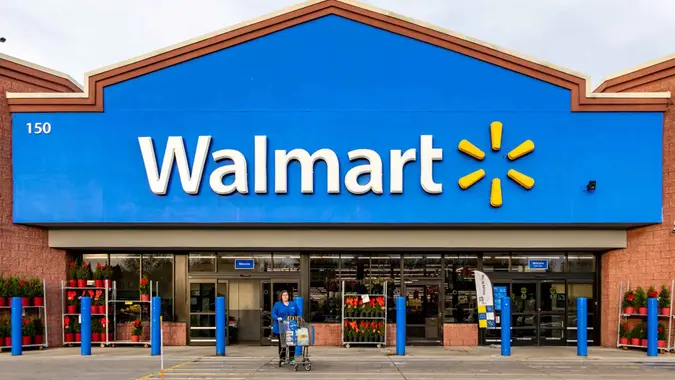I’m a Retired Boomer: Here Are 10 Grocery Items I Always Buy To Save Money

Commitment to Our Readers
GOBankingRates' editorial team is committed to bringing you unbiased reviews and information. We use data-driven methodologies to evaluate financial products and services - our reviews and ratings are not influenced by advertisers. You can read more about our editorial guidelines and our products and services review methodology.

20 Years
Helping You Live Richer

Reviewed
by Experts

Trusted by
Millions of Readers
The average U.S. consumer spends anywhere from $290 to $548 a month on groceries, depending on factors like dietary needs and location. That’s $3,480 to $6,576 a year. For those who live on a fixed income, as many retirees do, it never hurts to find new ways to cut costs — especially on those larger, more flexible expenses like groceries.
GOBankingRates spoke with Connie K. (born 1960) from Raleigh, North Carolina, to find out what grocery items she buys for her household of two to save money, as well as her top strategies for keeping costs low at the store.
Choosing the Right Grocery Items
“I tend to buy foods that are versatile, so I can change things up,” she said.
Noting that it’s not comprehensive, she shared the following list of items that she typically goes for at the store.
Hamburger (Ground Chuck)
- Estimated cost: $4.99/pound
- Meal options: Ground beef pasta, hamburgers, tacos
Chicken Breasts
- Estimated cost: $2.69/pound
- Meal options: Chicken and mushroom casserole, chicken and rice, curry dishes
Pork Tenderloins
- Estimated cost: $3.49/pound (boneless)
- Meal options: Pork tenderloins with roasted veggies
Whole Potatoes
- Estimated cost: $4.99 for a 5-pound bag of russet potatoes
- Meal options: Baked potatoes, breakfast casseroles
Cabbage
- Estimated cost: $0.59/pound
- Meal options: Stews, bacon fried cabbage, side salads
Onions
- Estimated cost: $1.29/pound
- Meal options: French onion soup, chicken and veggies, chicken pot pit
Canned Tomatoes
- Estimated cost: $0.98/14.5 ounces (diced)
- Meal options: Stews, soups, casseroles
Frozen Peas
- Estimated cost: $1.99/pound
- Meal options: Side dish, salad, chunky chicken and pea soup
Jasmine Rice
- Estimated cost: $4.39/2 pounds
- Meal options: Roast chicken and rice, stir fry
Vermicelli Pasta
- Estimated cost: $0.99 to $1.79/pound
- Meal options: Soups, meat and veggies and pasta
Strategies for Saving Money on Groceries
When it comes to groceries, versatility really is the name of the game. But it’s equally important to find other ways to save money at the store.
“Us retired boomers live on fixed incomes, and it can be quite challenging,” Connie said. “Saving money at the grocery store can help offset the cost of other monthly expenses, like utilities.”
She provided the following strategies she uses to save more when shopping for groceries:
- Diversify for the sales: “Find several stores that you like and always check their sales flyers (online or in the store),” she said. What could be marked at full price at your local Target could be on sale at Food Lion or Safeway.
- Get the rewards: “Sign up for their rewards cards and take advantage of their perks,” Connie said. Many grocery stores offer a free loyalty program you can sign up for at any time. All you typically need to get the discounts is your phone number, applied at checkout.
- Use coupons: “Clip coupons (physical or online),” Connie said. The average household saves between $5 and $10 a week with coupons. That’s $260 to $520 a year. You don’t have to just use manufacturer coupons. Rebate sites and free apps can also get you some great discounts on grocery items.
- Get the BOGO deals: Buy one, get one free deals essentially get you two items for the price of one — a major deal no matter who you are. Just be sure to take advantage of these deals on items you actually like and plan to use. Otherwise, whatever you buy will just sit in the back of the pantry or go to waste.
Perhaps the most important money-saving strategy she uses at the grocery store (and one she’s learned with age) is to not be a “brand snob.”
“Believe me, I know from personal experience,” she said. “Try the store brands to see if you like them as well as the bigger brand name items. Often, you will find very little difference, especially with staple items like butter, sugar, flour, milk, some canned foods, etc.”
When you look at the many different food categories and compare prices between store-brand and name-brand groceries, you’ll start to notice the difference. In fact, you could save roughly 40% on grocery items (altogether) by foregoing the name brands and buying store-brand items instead.
Disclaimer: All listed prices are based on store-brand options online at a grocery store local to the Raleigh area and are current as of Oct. 10, 2024.
More From GOBankingRates
 Written by
Written by  Edited by
Edited by 

























